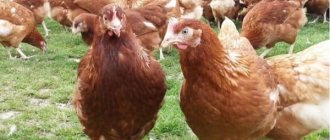When raising poultry, you will definitely be faced with the question of how many months laying hens start laying eggs. We will talk about this in more detail in this article. Raising chickens at home involves many different nuances. Most laying hens do not lay eggs immediately, but after some time. The egg production of chickens primarily depends on the breed, and only then on other related factors.
Important! Laying hens begin to lay eggs only when they reach sexual maturity. This happens approximately when the chicken has gained over 70% of its body weight. The average period for laying eggs in laying hens is 6 months. Small deviations in one direction will depend primarily on your conditions for keeping the bird, and only then on its breed.
At what month do laying hens start laying eggs?
Productivity terms
The theory states the ability of chickens to live and remain productive for 10 to 15 years. Nature has placed in the bird’s body a sufficient volume of eggs for long-term egg laying. Practice proves that it is unprofitable to keep chickens whose active egg-laying period has noticeably decreased.
Some chickens are capable of producing up to 300 eggs per year
Maintaining livestock without renewal over 2-3 years is unprofitable due to a decrease in the volume and number of clutches. In addition, in the case of egg and meat-egg varieties, the 3-4 year lifespan of birds leads to a significant change in the structure of the meat as a by-product.
The main condition for quons to begin laying eggs is the maturity of the bird’s two vital systems—reproductive and musculoskeletal.
Secrets of experienced poultry farmers
To create profitable egg production, you should pay attention to the following tips from experienced poultry farmers. The overall egg production depends largely not on the selected breed of chicken, but on the living conditions created for it.
- Chickens should not be allowed to overeat. Overfed individuals will stop laying eggs, will be more susceptible to disease, and will be weak and lazy;
- Chickens need quiet time. During the period from 8 am to 4 pm the herd should not be disturbed unnecessarily. A noisy environment and frequent interference in their life will provoke stress and a lack of eggs on this day. Barking and pursuit of chickens by dogs also negatively affect productivity indicators;
- Failure to comply with the temperature regime will affect the general condition of the individuals. At elevated temperatures, birds will try to leave the room; at lower temperatures, they will wait out unfavorable times, delaying laying.
- It has been proven that playing classical music in a chicken coop increases the total number of eggs laid by 11-14%.
- Keeping a rooster in the general flock promotes increased egg production.
Keeping a rooster in the general flock promotes increased egg production
To summarize, we can say that chickens are the most productive birds in terms of egg production. The early age at which eggs begin to be laid and low demands on living conditions make these birds the most attractive to novice poultry farmers. However, despite the relative simplicity, some mandatory conditions must be met to obtain a stable flow of domestic eggs.
Chickens need to equip the coop with a sufficient number of perches and feeders. Otherwise, you can provoke a struggle for the missing resource. The room itself should be divided into two components. This is a covered, heated and illuminated room and a free-running area for birds. The floor of the poultry house must be insulated with a thick layer of litter, otherwise the chickens will be susceptible to colds. Windows or vents must also be present. Ventilating the room is the key to reducing the spread of various pathogens. However, you should be wary of drafts.
A balanced diet plays one of the most important roles in the formation of eggs. When there is a deficiency or imbalance of nutrients, the fertile qualities of chickens are impaired and the process of laying eggs is delayed.
To check if your chickens are ready to lay eggs, you can do a self-inspection. Healthy, fertile chickens have a faint comb color, a small and dull beak, and yellowish paws. Chickens that are unable to lay eggs are characterized by weak comb development and bright coloring of both paws and earlobes. In addition, a dense belly and a wide set of pelvic bones are a signal for the ability to lay eggs.
By applying the described schemes in practice, even novice poultry farmers will not find it difficult to set up and obtain a profitable egg production facility.
0 0 votes
Article rating
The process of egg laying in different chickens
The question requires a detailed consideration of the capabilities of representatives of each variety.
Egg breeds
For chickens sent to a home pen and raised for eggs, the first clutches are typical at 17-20 weeks, that is, at the age of 4.5-5.5 months. Numerous varieties of this trend (Hamburg, Laurent Brown, Hein Line, Tetra Tl, Czech Golden, Ukrainian Ushanka, Leghorn) are characterized by high rates of egg production, along with a high degree of depletion of the bird’s body, which causes a reduction in the period of their keeping to 1.5 years .
Attention! After 1.5 years, the number of testicles is reduced by almost 2 times. Keeping poultry with such productivity becomes unprofitable.
Pullets
These are called sexually mature birds that are capable of producing a full-fledged product. They are distinguished by their small size and pale pink crest.
Age is not the main indicator of fruiting in birds. It is worth taking into account the time of year and diet: chickens born at the end of winter or in the spring will begin to lay eggs earlier.
The warm season and balanced nutrition lead to a rapid gain by young animals of 75-80% of the weight of an adult specimen, which contributes to the regular supply of product after 150 days.
Meat varieties and crosses
A strong build and significant (6-7 kg) weight are the hallmarks of meat chickens (Plymouth Rock, Brahma, Cochin, Cornish, Sussex). Their ability to produce offspring is updated by 210-240 days of life.
The later period of oviposition, along with low productivity (100-130 eggs/year), is compensated by a significant mass of the product - 65-75 g.
Strong physique - distinctive characteristics of meat chickens
Meat and egg varieties
Indicators of active laying for meat-egg-type quons (Rhode Island, Oryol, Augsburger, Jubilee Kuchinsky, New Hampshire) are fixed at 21-24 weeks, but are characterized by average indicators.
Broiler chickens
At what age do hens start laying eggs in this variety? Broilers live very short - about 60-65 days, until they reach a certain weight. However, promising quons not only lay eggs, but, gradually, by week 30-32, they bring not a small, but a standard and even larger product.
For reference! The intensive period of egg laying reduces the quality of their meat, which is definitely not liked by most breeders.
What to feed chickens so they lay eggs every day
You can take the simplest route and buy complete feed for chickens (PK-1-1 and PK-1-3). This food will fully provide protein, vitamins and minerals. The feed consists of medium and small granules; feed it dry, without steaming or filling it with water. Do not add any additional additives to such food, this will only cause harm. Additionally, chickens can only be given a little greenery.
Feeding with compound feed also has disadvantages:
- short shelf life (no more than 3 months);
- high price (from 30-40 rubles per 1 kg);
- The taste of a homemade chicken egg will not differ from the taste of a store-bought egg.
If you want to give up industrial feed, but maintain livestock productivity at a high level, make your own feed. It will take time and some effort, but the result is worth it.
In order for chickens to lay eggs well, the protein content in the feed should not be lower than 17%, which is ensured by the introduction of cake and fish meal into the feed. The basis of the feed mixture is crushed or rolled grain of wheat, barley, corn, in a ratio of 1:0.5:1. Add to this mixture:
- 10% wheat bran;
- 8% sunflower cake;
- 4% fish or meat and bone meal;
- 0.5% table salt.
Shell rock or chalk is added to the finished mixture in an amount of 2% of the total weight of the feed, and a premix (Zdravur, Ryabushka). The premix contains a complex of vitamins; it is especially necessary in winter, when the herd sits indoors.
Do you add premixes to the food?
Not really
In summer, give plenty of greens in a separate feeder. In winter, feed hay crushed into flour 5-8 g per head per day.
The norm for feeding the grain mixture with all additives per chicken is 120-150 g per day. Do not exceed this norm so that the hen does not become fat. Feed can be given to chickens in the form of wet crumbly mash, with the addition of food waste, dairy products, and vegetables.
Do not give your chickens salty, sweet or spicy foods, this can lead to poisoning!
Laying hens are fed at home twice a day.
Reproductive age: determination criteria
A distinctive feature of a chicken ready for the reproductive period is its comb, which acquires a bright color and increases in size. There are a number of other criteria that help identify individuals with high productive qualities:
- examination and observation (behavior, temperament);
- productivity control (different times), assessment of masonry quality.
It is easy for experienced breeders to distinguish young animals.
It is easy for experienced breeders to distinguish young animals that have not reached one year old according to such criteria as:
- beak (powerful, curved, smooth with a yellow tint);
- paws (yellow color, without gray tones, growths, cracks; small claws, without delamination);
- comb and lobes (bright pigmentation, high temperature of the comb/lobes due to active blood supply);
- abdomen (palpation demonstrates soft tissue without significant fat deposits);
- plumage (bright color, smoothness, softness of the down; disheveled appearance of the feather indicates the age or illness of the individual);
- weight, taking into account the variety and direction of breeding: egg type - at six months of age approximately 1.5 kg;
- pigmentation (bright);
- eyes (bulging, clear, shiny without clouding or foamy formations);
- behavior (active search for food, constant movement, duration of walks);
- physique (soft, light structure, rounded chest);
- change of plumage (time of molting, change of primary feather, occurs before six months and active egg laying);
- productivity (within 2 weeks, feel the exit of the oviduct daily to identify an egg in it; 1 egg per week is an age indicator not older than six months; older birds bring up to 3-6 eggs per week);
- quality of eggs (small product 45 g, with a strong, thick shell and high nutritional value);
- yolk (large, rich color, thick consistency).
Additional Information! A young brood, when examined, will show small blue veins and pink skin, which, over time, dries out, dulls and becomes rough.
The beginning and duration of the period when a bird can actively become infected depends on factors such as the variety, housing conditions and direction.
Choosing a good layer
To select a chicken capable of producing eggs, it is necessary to conduct a visual and contact inspection of it.
A good layer does not sit still. She is active and fast, often rummaging in the ground and litter in search of edible things.
Be sure to check the distance between the protruding thigh bones. They are also called pubic. If it is three fingers folded together, this indicates a good laying hen. Between these bones and the keel (the ridge of the protruding sternum) two or three fingers fit.
Poor productive qualities of a chicken are indicated by: a broken beak, brightly colored legs, and a wrinkled, cool comb.
But you shouldn’t immediately give up on rejected birds. Perhaps their time has not yet come. Or the reason lies in improper living conditions or poor nutrition.
If you correct the situation, there is a chance that the chicken will still get pregnant. There will be no questions left on this topic if you read the article “What determines egg production in chickens and how to increase it at home.”
If you found the article useful, please rate it 5 stars. In the comments, you can discuss the information you have read, share your opinion or experience in raising chickens. Reposting will attract friends to the conversation.
Source: znaipticu.ru
Intensity of masonry: influencing factors
Experts say that the intensity of masonry can be adjusted using:
- nutrition (quality, balance; makha, chalk, sand, water, fresh vegetation);
- temperature (warm room, additional heating, ventilation);
- daylight hours - 14 hours (additional lighting);
- cleanliness of the chicken coop and the presence of fresh hay in the nest;
- walking areas;
- feeding regimen.
Compliance with simple rules will allow you to preserve and increase the reproductive abilities of laying hens.
Practical tips for increasing productivity
When chickens begin to lay eggs, it is necessary to change their diet as quickly as possible and give more feed. In addition to feeding, when the hen lays eggs, the quality indicators will be affected by the length of daylight hours - it must be artificially increased. Poultry houses need to be well prepared for the winter:
- securely close all cracks so that there are no drafts;
- insulate the room;
- install a basic ventilation system.
Experienced breeders say that when your chickens start laying eggs, you need to create a feeding plan. For beginners, it is recommended to describe it to yourself on paper and count the amount of food, because you should not overfeed or underfeed your pets. The daily diet should include proteins, vegetable fats, fast carbohydrates, phosphorus and calcium. For the most part, the diet consists of various grains, some root vegetables, and you can add cottage cheese.
The quality of egg production will also be affected by how many chickens will live in one room. Ideally per 1 sq. m there should be 4 laying hens. During periods of severe frost, it is not advisable to take livestock out for walking. Another important point in keeping is treatment against parasites and vaccination.
Varieties of chickens with high egg production rates
Egg direction:
- leghorn (wide chest, voluminous belly, feather color is predominantly light, black-and-white and brown-striped, 230-240 eggs/year);
- loman brown (mixed universal type, active, early ripening, 300-320 pcs./year);
- Hein-line (cross with the characteristics of equanimity, calmness, good immunity, high productivity and vitality, more than 300 eggs/year);
- tetra tl (universal type with rapid weight gain, fertility from 300 to 310 eggs/year);
- hisex (hybrid, rapid puberty, long-lasting, high egg production, 300-350 pcs./year, good taste of meat);
- Czech golden (active, unpretentious, 200 pcs./year);
- Ukrainian earflaps (hardy, adaptive, good immunity, red feather color, 150-170 pieces/year);
Chickens rhodonite
Meat and egg direction:
- Rhode Island (original name “red Rhode Island”, 160-170 pieces/year, tasty meat, unpretentious);
- Orlovskaya (hardy, productive, unpretentious, late maturation, up to 180 eggs/year, high taste);
- Augsburger (feature: butterfly-shaped comb, up to 230 eggs/year, hardy, requires nutritional control);
- Kuchinsky Jubilee (unpretentious, calm, 180-200 pieces per year);
- Sussex (calm, adaptive, high productivity, often confused with dominant crosses, tender meat, 160-190 eggs per year, excellent taste);
- New Hampshire (friendly, 170-250 eggs per year, early maturation, reproductive cycle - two years, rapid weight gain);
- Adler silver (fast growing, adaptive, friendly, productivity up to 4 years, 200 eggs per year).
The process of conception and hatching of an egg
The formation of the egg occurs cyclically and quickly - throughout the day. The egg released from the follicle enters the oviduct, through which it moves for 12 hours. It is this time that is necessary for the formation of the main components of the egg - the yolk, white and shell.
The cycle begins 40 minutes after the egg is hatched from the hen's body, when the new egg begins to move.
Important! Genetically, each bird has a predetermined number of eggs that it can lay in its entire life.
From the beginning to the end
To understand how egg laying occurs, you need to understand in detail how chickens lay eggs. In the body of every female individual there are many eggs, from which eggs are formed.
The whole process occurs in several stages
- Formation of the yolk. First, the egg grows overgrown with the first shell, inside which the yolk is formed, after which the future egg descends into the oviduct.
- Protein formation. While the yolk moves through the oviduct, it is overgrown with another additional membrane - a white is formed.
- Shell formation. The formation of a hard protective coating occurs in one of the sections of the oviduct. But if there is not enough calcium in the chicken’s diet, then the shell does not form and the fetus comes out without it, which is considered a defect.
The process takes 20–24 hours, so the bird does not lay eggs more than once a day.
When a chicken lays an egg, she needs an hour to recover. After the bird rests, the formation of a new yolk begins.
Source: 1kyra.ru
Chickens: laying duration
Picture 5 Conditions of detention are the key to good egg production
But fat deposits that appear after a year interfere with full productivity, which affects the quality and quantity of eggs.
- Egg direction - active productivity for 1.5-2 years (up to 300 clutches per year).
- Meat-egg direction - egg laying lasts up to 4 years (up to 170 pcs./year).
- Meat direction - 2-3 years, subject to laying no more than 3 eggs per week. With good care and proper maintenance, the bird can produce up to 130 eggs per year.
The age at which hens begin laying eggs depends on the variety. Laying hens have the ability to actively lay eggs until they reach the age of three years.
Temporary, short breaks in the process of laying eggs are caused by such criteria as: change of plumage, stress, poor living conditions, improper food.
Quality of egg products
Standard store eggs have a significant difference from products obtained from young animals. They are inferior in size and weight, but the quality is always at its best. Over time, the size of the eggs will reach a certain norm and an average weight of 60 grams. It all depends on the breed characteristics of the birds.
In chickens at birth, the supply of eggs is calculated in such a way that it is enough for the entire period of life. How long will it take for the egg to become a full-fledged product? This will take about a day.
The following table will look in more detail at how many eggs and from which groups you can get
| Name | Quantitative indicator for 365 days | Note |
| Egg direction | 170–240 pieces | From leghorns you get up to 340 pieces |
| Meat-egg chickens | 170 eggs | |
| Meat poultry | Up to 120 pieces | This is due to the rapid onset of feather cover change. It is worth noting that the products are larger compared to other breeds |
Factors influencing the increase in the quantity and quality of eggs
High and stable egg production can be ensured by:
- regulation of livestock of different ages (40% adults, 60% young animals);
- correct, timely feeding (proteins, vitamins, minerals, fresh herbs, vegetable flour, sprouted grains, etc.);
- living conditions (14-hour daylight hours, moderate lighting, acceptable temperature conditions, place for walking);
- variety (Leghorn, New Hampshire, Sussex, Minorca, etc.).
Regular renewal of livestock is the key to a quality product.
These measures can have a good, but short-lived effect. Renewal of livestock, gradual and correct, is the key to a constant and high-quality product.
Reasons for stopping masonry
If the reasons for the termination of laying are not associated with the age characteristics of the birds, then the issue may be:
- untimely and insufficient diet;
- improper care;
- process of changing plumage (autumn);
- state of immunity;
- stress;
- hormonal imbalances.
Conditions and food
Egg production, as an indicator of a healthy population, may decrease due to improper diet. Equipped premises will help correct the situation. These are comfortable perches, nests, drinking bowls, and feeders in sufficient quantities.
Balanced food and vitamins added to food (cereals, legumes, dairy, fish mash, insects, worms, shells).
Comfortable conditions are the key to good productivity: additional lighting, warmth, walking areas, dry premises, good ventilation, ash baths.
Bad weather
Breeders know that chickens are shy. If unfavorable weather conditions (rain, thunderstorm) persist for a long time, then apple cider vinegar is introduced into the diet. For seven days, it is introduced into the diet in a volume of 20 ml.
Diseases
Disease is a serious reason for reducing egg laying. If the livestock or individual individuals look lethargic, feed inactively, there is blood in the waste products or parasites are found, the appearance of ulcers, loss of feathers, temperature, mucus, etc. is noted, then the help of a veterinarian is required, who can quickly determine the cause of the ailment ( infectious, non-infectious) and take measures to restore the health of the livestock.
Attention! Timely preventive measures prevent the occurrence of obvious and hidden diseases.
Organization of walking
Free but controlled range is a great way to offer better conditions not only for seeking additional nutrition, but also for releasing pent-up energy. Free range teaches birds to lay eggs in prepared nests.
Seasons
In late spring, summer and early autumn, birds receive sufficient light and fresh food rich in vitamins and minerals. A decrease in air temperature and a change in diet are conditions leading to a decrease in egg production.
As daylight hours shorten, additional lighting is required and the temperature in the chicken coop increases to 23 degrees.
As daylight hours shorten, additional lighting is required
Replacement of livestock
The quantity and quality of eggs depends on how old the chicken is
It is important to periodically replace the stock. This is done naturally or through an incubator.
In any case, a rooster is required. Its practical use lies only in fertilizing eggs.
You also don't have to hold it. Then you will need to buy chicks from breeders, but this is a little more expensive.
Hatching eggs
Here's how to change the livestock:
- after hatching, the chickens and their mother are placed in a separate pen, where she will monitor them (the chicks need high-quality food and enough water from the first hours of life to reduce mortality, it is also recommended to give them vitamins);
- if the chickens are hatchery, then they are placed in a separate pen without a laying hen;
- in the second week, the chicks can be placed in a common chicken coop;
- By the time of the first laying, the oldest hens must be removed and sent for meat.
This is a natural process that will allow the farmer to earn income from eggs and meat. You should not change more than 30% of the livestock.











